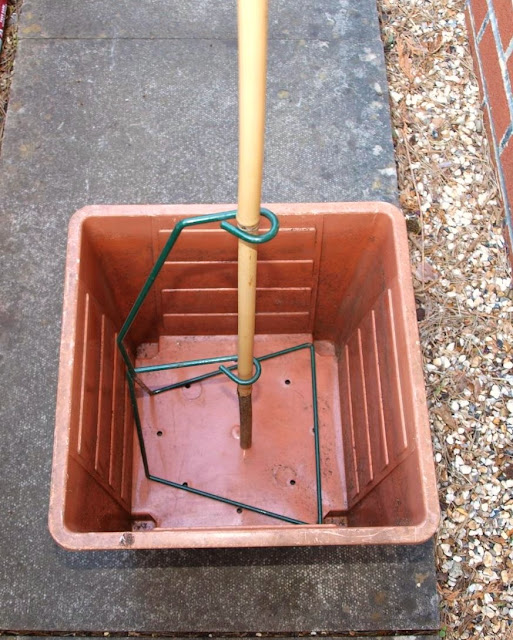Most tomatoes fall into one of two categories.
First there are the so-called "Indeterminate" ones, which grow as long or tall vines and keep on producing trusses of fruit until you stop them by pinching-out the growing tip. If you didn't pinch it out, a tomato vine could potentially grow to 20 feet, or perhaps more. Typically these types are grown upright, as "cordons", with the support of canes or strings, and their sideshoots are removed to keep the plants slim and make them concentrate their energy on producing fruit.
Then there are the "Determinate" types, often referred to as "Bush tomatoes". They typically grow as low bushes, often spreading out to cover a large area, and sideshoots are not removed. Their fruit usually matures all at approximately the same time.
Many of the tomatoes I like best are Indeterminate ones, and I grow these in big containers and provide the plants with stout canes for support. A couple of years ago I purchased some big (35-litre) black plastic containers which I now consider ideal for cordon tomatoes. The containers I had used prior to this were really too small for growing big tomato plants, and would often dry out too quickly.
These containers come complete with carrying-handles (shifting a full one is a two-person job!) and drainage holes. An added bonus for me is that they are big enough to accommodate the metal cane-supports that I always use. The supports don't fit in small pots.
I normally stop my Indeterminate tomatoes growing any taller (by pinching out the growing tip) once they have produced 4 or 5 trusses of fruit. This normally means they will be about 5 feet tall - perhaps a bit more.
In previous years I have found that the weight of fruit can make the plants top-heavy which can lead to the pot toppling over, so it will be interesting to see if the bigger pots prevent this.
I treat the Determinate tomato varieties differently. For a start, I usually only provide them with a short (maybe 2-foot) cane, or sometimes none at all. This allows them to sprawl, as seen below:
Some types of tomato, including one of my favourites - "Maskotka" - like to trail downwards, and in the last couple of years I have taken to planting some of them in a 3-foot tall wooden planter which gives them plenty of scope for dangling:
I have done the same this year. The planter conveniently holds two plastic crates, each of which can take two "Maskotka" plants.
I filled the crates with a humus-rich mixture of 50% commercial and 50% homemade compost, which is pretty moisture-retentive, but even so I find I have to water the plants twice most days.
In rather similar fashion I have provided downward-growing opportunities for some more plants by balancing some large pots on top of each other, like this:
Those pots are ones in which I was growing big Indeterminate tomatoes last year - clearly too small! The plant seen here is a "Montello". Look how it has grown:
Actually, in that photo there are four tomato plants. The two bigger, darker ones are "Montello" and the two smaller ones are "Maskotka". The latter are plants that were spares that I just couldn't bear to throw away. They were kept in very small pots for far too long and will probably never recover fully from that, but they look as if they will give me a respectable crop in any case.
This year I am trying for the first time a completely new type of tomato plant - the Dwarf. This type have been bred specifically to be small, and thus to appeal to amateur growers without much available space. I have been introduced to these by Craig LeHoullier, author of the book "Epic Tomatoes" and a leading light in the project to develop the Dwarf tomatoes. He kindly sent me some seeds for various varieties, and I'm growing some to see how they perform in my garden. Early signs are good - the plants look strong and healthy (and short!).
If you want to know more about the Dwarf tomato project, you can read about it HERE.
I would just like to end this post by saying that there are loads of different ways to grow tomatoes, and I have only described a few of them. As the saying goes, the best way to grow tomatoes is the way that works for you. My tomatoes are all grown outdoors once they have passed the seedling stage, because I don't have a greenhouse or polytunnel, but if I did I might well try some other methods too. Still, in most years I manage to get a pretty decent crop, even though Blight and weedkiller-contaminated compost have sometimes taken their toll!












For my first dwarf tomato I am hedging my bets a bit and trying Totem. Small plant with big tomatoes - according to the blurb! I have tried a "currant" variety but was not overly pleased with the resulting mini fruit.
ReplyDelete"Totem" is a bush variety, Mal, a Determinate type, whereas these new Dwarfs are Indeterminate types that just don't grow very tall. Allegedly they fruit in succession, unlike the bush varieties which fruit more or less all at once. We shall see...
DeleteI see, And I should have done a bit more reading before rushing to post. I will be intrigued by your findings
DeleteWe're growing a very diminutive variety called Red Robin. It's described as being suitable for growing in a windowsill so we have three or four plants to one containers. I'm not sure how big the fruits will be bit it has lots of babies.
ReplyDelete